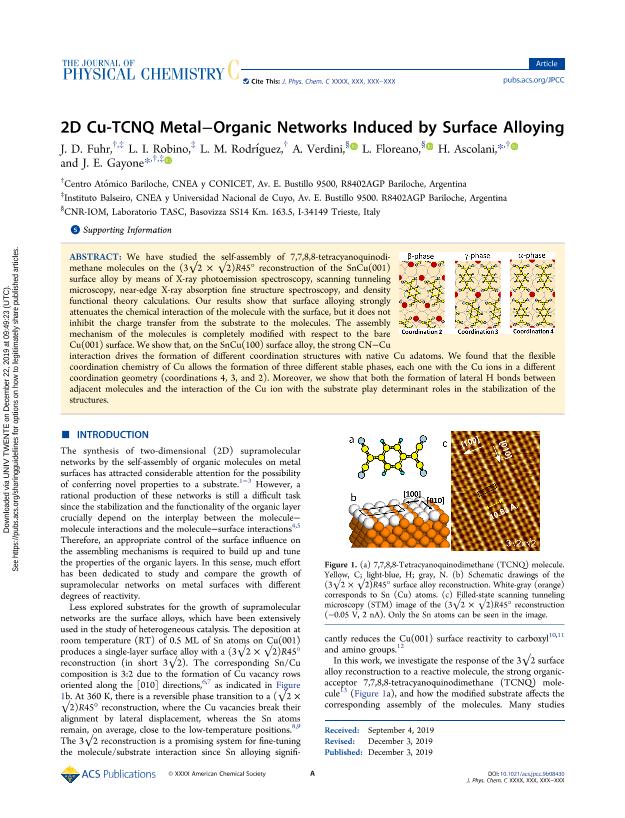Mostrar el registro sencillo del ítem
dc.contributor.author
Fuhr, Javier Daniel

dc.contributor.author
Robino, L.I.
dc.contributor.author
Rodríguez, L.M.
dc.contributor.author
Verdini, A.
dc.contributor.author
Floreano, L.
dc.contributor.author
Ascolani, Hugo del Lujan

dc.contributor.author
Gayone, Julio Esteban

dc.date.available
2021-01-26T15:13:09Z
dc.date.issued
2019-12
dc.identifier.citation
Fuhr, Javier Daniel; Robino, L.I.; Rodríguez, L.M.; Verdini, A.; Floreano, L.; et al.; 2D Cu-TCNQ Metal-Organic Networks Induced by Surface Alloying; American Chemical Society; Journal of Physical Chemistry C; 124; 1; 12-2019; 416-424
dc.identifier.issn
1932-7447
dc.identifier.uri
http://hdl.handle.net/11336/123755
dc.description.abstract
We have studied the self-assembly of 7,7,8,8-tetracyanoquinodimethane molecules on the (3√2 × √2)R45° reconstruction of the SnCu(001) surface alloy by means of X-ray photoemission spectroscopy, scanning tunneling microscopy, near-edge X-ray absorption fine structure spectroscopy, and density functional theory calculations. Our results show that surface alloying strongly attenuates the chemical interaction of the molecule with the surface, but it does not inhibit the charge transfer from the substrate to the molecules. The assembly mechanism of the molecules is completely modified with respect to the bare Cu(001) surface. We show that, on the SnCu(100) surface alloy, the strong CN-Cu interaction drives the formation of different coordination structures with native Cu adatoms. We found that the flexible coordination chemistry of Cu allows the formation of three different stable phases, each one with the Cu ions in a different coordination geometry (coordinations 4, 3, and 2). Moreover, we show that both the formation of lateral H bonds between adjacent molecules and the interaction of the Cu ion with the substrate play determinant roles in the stabilization of the structures.
dc.format
application/pdf
dc.language.iso
eng
dc.publisher
American Chemical Society

dc.rights
info:eu-repo/semantics/openAccess
dc.rights.uri
https://creativecommons.org/licenses/by-nc-sa/2.5/ar/
dc.subject
SURFACES
dc.subject
METALLORGANICS
dc.subject
ALLOYS
dc.subject
MONOLAYERS
dc.subject.classification
Física de los Materiales Condensados

dc.subject.classification
Ciencias Físicas

dc.subject.classification
CIENCIAS NATURALES Y EXACTAS

dc.title
2D Cu-TCNQ Metal-Organic Networks Induced by Surface Alloying
dc.type
info:eu-repo/semantics/article
dc.type
info:ar-repo/semantics/artículo
dc.type
info:eu-repo/semantics/publishedVersion
dc.date.updated
2020-12-23T20:14:12Z
dc.journal.volume
124
dc.journal.number
1
dc.journal.pagination
416-424
dc.journal.pais
Estados Unidos

dc.journal.ciudad
Washington
dc.description.fil
Fil: Fuhr, Javier Daniel. Universidad Nacional de Cuyo; Argentina. Comisión Nacional de Energía Atómica. Centro Atómico Bariloche; Argentina. Comisión Nacional de Energía Atómica. Gerencia del Área de Energía Nuclear. Instituto Balseiro; Argentina. Consejo Nacional de Investigaciones Científicas y Técnicas; Argentina
dc.description.fil
Fil: Robino, L.I.. Universidad Nacional de Cuyo; Argentina. Comisión Nacional de Energía Atómica. Gerencia del Área de Energía Nuclear. Instituto Balseiro; Argentina
dc.description.fil
Fil: Rodríguez, L.M.. Comisión Nacional de Energía Atómica. Centro Atómico Bariloche; Argentina
dc.description.fil
Fil: Verdini, A.. No especifíca;
dc.description.fil
Fil: Floreano, L.. No especifíca;
dc.description.fil
Fil: Ascolani, Hugo del Lujan. Comisión Nacional de Energía Atómica. Centro Atómico Bariloche; Argentina. Consejo Nacional de Investigaciones Científicas y Técnicas. Oficina de Coordinación Administrativa Ciudad Universitaria. Unidad Ejecutora Instituto de Nanociencia y Nanotecnología. Unidad Ejecutora Instituto de Nanociencia y Nanotecnología - Nodo Bariloche | Comisión Nacional de Energía Atómica. Unidad Ejecutora Instituto de Nanociencia y Nanotecnología. Unidad Ejecutora Instituto de Nanociencia y Nanotecnología - Nodo Bariloche; Argentina
dc.description.fil
Fil: Gayone, Julio Esteban. Consejo Nacional de Investigaciones Científicas y Técnicas. Oficina de Coordinación Administrativa Ciudad Universitaria. Unidad Ejecutora Instituto de Nanociencia y Nanotecnología. Unidad Ejecutora Instituto de Nanociencia y Nanotecnología - Nodo Bariloche | Comisión Nacional de Energía Atómica. Unidad Ejecutora Instituto de Nanociencia y Nanotecnología. Unidad Ejecutora Instituto de Nanociencia y Nanotecnología - Nodo Bariloche; Argentina. Comisión Nacional de Energía Atómica. Gerencia del Área de Energía Nuclear. Instituto Balseiro; Argentina
dc.journal.title
Journal of Physical Chemistry C

dc.relation.alternativeid
info:eu-repo/semantics/altIdentifier/url/https://pubs.acs.org/doi/abs/10.1021/acs.jpcc.9b08430
dc.relation.alternativeid
info:eu-repo/semantics/altIdentifier/doi/http://dx.doi.org/10.1021/acs.jpcc.9b08430
Archivos asociados
